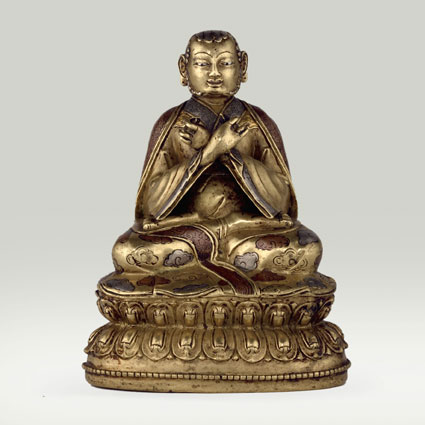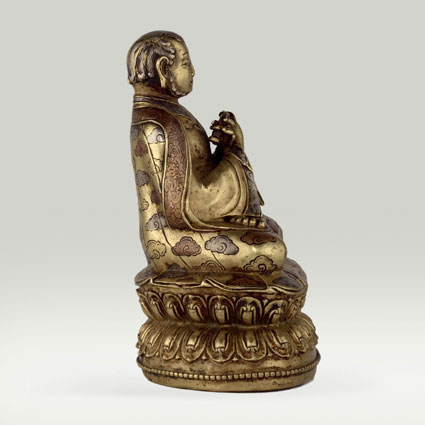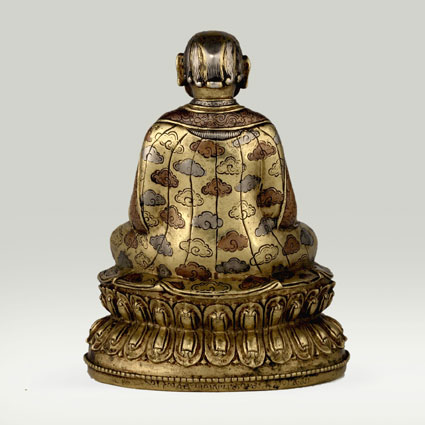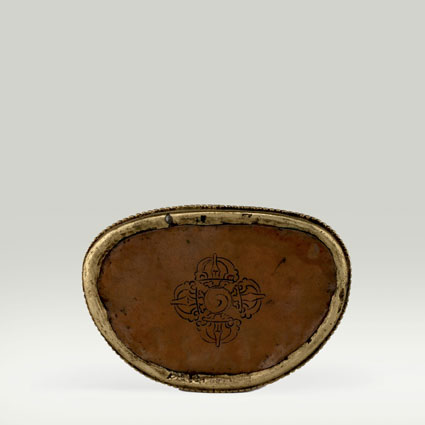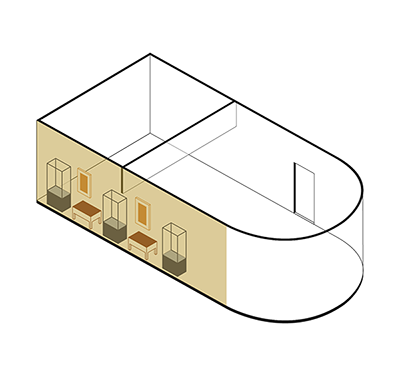ABS 079
Code: ABS 079
Country: Tibet (south)
Style:
Date: 1400 - 1500
Dimensions in cm WxHxD: 9.8 x 13.4 x 7.1
Materials: Brass; inlaid with gold, silver, and copper
The eyes are inlaid with "silver", the pupils filled in with a black lacquer-like substance, and the lips are inlaid with copper.
The monastic garments are extensively inlaid with "silver" and copper emblems and two segments with gold, the borders decorated with engraved floral patterns and the upper garment with clouds.
The bottom of the pedestal is sealed with a copper sheet decorated with the visvavajra emblem.
Grags pa rgyal mtshan (1147–1216), identified as such by an inscription, was the fifth throne holder (khri pa) of the Sa skya Monastery (1159–?). With facial expressions of a portrait like nature he is seated in the diamond attitude (vajraparyankasana) on a double lotus pedestal. The hands are crossed over the chest and turned inwards (prajnalingabhinaya) holding a diamond sceptre (vajra) and a prayer-bell (ghanta). He is clad with a voluminous array of monastic garments.
On the back side of the pedestal is a Tibetan inscription in dBu can script: // lha btsun grags pa rgyal mtshan la na mo//. “Hail to lHa btsun Grags pa rgyal mtshan”.
Sakya is one of the four different sects of the Tibetan Buddhism. The Sakyapa tradition takes its name from the monastery founded in 1073 at Sakya (“the place of grey earth”) in south-western Tibet by Konchog Gyalpo, a member of the Khon clan. This influential family had previously owed allegiance to the Nyingmapa tradition but Konchog Gyalpo studied the theories and methods of the new diffusion of tantras current in eleventh century Tibet. The most important of the teachings, which he received from his teacher Drokmi Lotsava, a disciple of the Indian scholar Gayadhara, was the meditational system known as the Path and Its Fruit (Lam-‘Dre).
In the twelfth and thirteenth centuries, the Sakya tradition rose to a position of prominence in the religious and cultural life of Tibet. This was due largely to the endeavours of the five great masters:
1. Sachen Kunga Nyingpo (1092-1158)
2. Sonam Tsemo (1142-1182)
3. Drakpa Gyaltsen (1147-1216)
4. Sakya Pandita (1182-1251)
5. Chogyal Phakpa (1235-1280)
Since that time the tradition and its two principal subsets, the Ngor sub-set founded by Ngorchen Kunga Sangpo (1382-1457) and the Tsar sub-set founded by Tsarchen Losal Gyamtso (1502-1556) and Dzongpa sub-set founded by Dorje Denpa Kunga Namgyal have been adorned by the labours and spiritual blessings of numerous illustrious yogis and scholars. Now the Sakya tradition under the compassionate guidance of His Holiness the Sakya Trizin (b. 1945), magnificent incarnation of the Khon line, is putting down roots outside Tibet in India.
His Holiness the Sakya Trizin fled to India in 1959 after the Chinese invasion of Tibet. In exile, His Holiness met all the religious leaders in 1963 including His Holiness the Dalai Lama and took permission to set up a monastery to preserve the Sakya tradition and heritage of Tibetan religion and culture. Thus He created Sakya Centre which is located in Rajpur, North of India. Thereafter Sakya Institute was created at Puruwala to impart higher education in Buddhist philosophy. At Puruwala, a Tibetan settlement was also established for the people of Sakya.
Sakya Centre is regarded as the main monastery of His Holiness the Sakya Trizin and the Sakya Lineage outside Tibet.
Sakya Monastery
(From Wikipedia, the free encyclopedia)
Sakya Monastery, also known as dPal Sa skya or Pel Sakya ("White Earth" or "Pale Earth") is a Buddhist monastery situated 25 km southeast of a bridge which is about 127 km west of Shigatse on the road to Tingri in the Tibet Autonomous Region of China.
The seat of the Sakya or Sakyapa school of Tibetan Buddhism, it was founded in 1073, by Konchok Gyelpo (1034-1102), originally a Nyingmapa monk of the powerful noble family of the Tsang and became the first Sakya Trizin. Its powerful abbots governed Tibet during the whole of the 13th century after the downfall of the kings until they were eclipsed by the rise of the new Gelukpa school of Tibetan Buddhism.
Its medieval Mongolian architecture is quite different from that of temples in Lhasa and Yarlung. The only surviving ancient building is the Lhakang Chempo or Sibgon Trulpa. Originally a cave in the mountainside, it was built in 1268 by Ponchen Sakya Sangpo in 1268 and restored in the 16th century. It contains some of the most magnificent surviving artwork in all of Tibet, which appears not to have been damaged in recent times. The Gompa grounds cover more than 18,000 square metres, while the huge main hall covers some 6,000 square metres.
Most of the buildings of the monastery are in Ruins, because they were destroyed during the Cultural Revolution.
Das Sharat Chandra writes:
“As to the great library of Sakya, it is on shelves along the walls of the great hall of the Lhakhang chen-po. There are preserved here many volumes written in gold letters; the pages are six feet long by eighteen inches in breadth. In the margin of each page are illuminations, and the first four volumes have in them pictures of the thousand Buddhas. These books are bound in iron. They were prepared under orders of the Emperor Kublai Khan and presented to the Phagpa lama on his second visit to Beijing.
There is also preserved in this temple a conch shell with whorls turning from left to right [in Tibetan, Ya chyü dungkar; and in Chinese Yu hsuan pai-lei], a present of Kublai to Phagpa. It is only blown by the lamas when the request is accompanied by a present of seven ounces of silver; but to blow it, or have it blown, is held to be an act of great merit."
A huge library of as many as 84,000 scrolls were found sealed up in a wall 60 metres long and 10 metres high at Sakya (Ch: Sagya) Monastery in 2003. It is expected that most of them will prove to be Buddhist scriptures although they may well also include works of literature, and on history, philosophy, astronomy, mathematics and art. They are thought to have remained untouched for hundreds of years. They are being examined by the Tibetan Academy of Social Sciences.
Sakya Monastery in India
The current Sakya Trizin, trone holder of the Sakyapa went in exil in India in 1959 and he is now living in Dehra Dun. As all the leaders of the Sakya school, he is married. He has two sons, and the younger ones, Dungsey Gyana Vajra, born July 5, 1979 in Dehra Dun, is a monk and direct the Sakya Monastery constructed in India.
Grags pa rgyal mtshan (1147–1216)
- or rJe btsun rin po che Grags pa rgyal mtshan, was the fifth throne holder of the Sa skya monastery (Sa skya khri pa) (1159 – ?) and the third of the five “Supreme Ones of Sa skya” (gong ma lnga). It is traditionally believed that he received the instructions of the lam ’bras doctrine from Kun dga’ snying po (1092–1158) during a vision.
Bock, Etienne; Falcombello, Jean-Marc; Jenny Magali, 2022. Trésors du Tibet. Sur les pas de Milarépa.. Paris: Flammarion. p. 74
Kreijger, Hugo E. , 1989. Godenbeelden uit Tibet: Lamaïstische Kunst uit Nederlands particulier bezit [catalogue of the exhibition held in the museum voor Volkenkunde in Rotterdam]. Den Haag: Gegevns Koninkljike Bibliotheek. P. [58]: Grags-pa-rgyal-mtshan. Central Tibet, 15th–16th century
von Schroeder, Ulrich, 2010. Buddhist Sculptures of the Alain Bordier Foundation. Hong Kong: Visual Dharma Publications, Ltd.. Pp. 46–47; plate 20A

